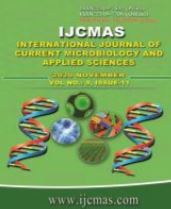


 National Academy of Agricultural Sciences (NAAS)
National Academy of Agricultural Sciences (NAAS)

|
PRINT ISSN : 2319-7692
Online ISSN : 2319-7706 Issues : 12 per year Publisher : Excellent Publishers Email : editorijcmas@gmail.com / submit@ijcmas.com Editor-in-chief: Dr.M.Prakash Index Copernicus ICV 2018: 95.39 NAAS RATING 2020: 5.38 |
A field experiment was conducted during kharif season of 2019 at the Experimental Farm, Department of Agronomy College of Agriculture, Latur to study the effect of integrated nutrient management in sweet corn (Zea mays L.var. saccharata sturt). The objective of experiment was to study the effect of integrated nutrient management on sweet corn and to work out the economics of sweet corn. The experiment was laid out in a randomized block design with seven treatments and replicated thrice. The treatments were T1- 100% RDF, T2 - 100% RDF + FYM @ 5 t ha-1, T3 - 75% RDF + FYM @ 5 t ha-1, T4 - 100% RDF + Vermicompost @ 2.5 t ha-1, T5 - 75% RDF + Vermicompost @ 2.5 t ha-1, T6 - 100% RDF + FYM @ 5 t ha-1 + Vermicompost @ 1.25 t ha-1+ Azospirillum and T7 -75% RDF + FYM @ 5 t ha-1 + Vermicompost @ 1.25 t ha-1 + Azospirillum. The result revealed that green cob yield (10621 Kg ha-1) and green fodder yield (21824 Kg ha-1) of sweet corn were significantly highest with the application of 100% RDF + FYM @ 5 t ha-1 + Vermicompost @ 1.25 t ha-1 + Azospirillum. The protein content did not differ significantly among the treatments whereas the highest content was observed with application of 100% RDF + FYM @ 5 t ha-1 + Vermicompost @ 1.25 t ha-1 + Azospirillum. The highest net returns (`90311 ha-1), gross returns (`153062ha-1) and B:C ratio 2.44 highest was recorded in the application of 100% RDF + FYM @ 5 t ha-1 + Vermicompost @ 1.25 t ha-1 + Azospirillum.
 |
 |
 |
 |
 |